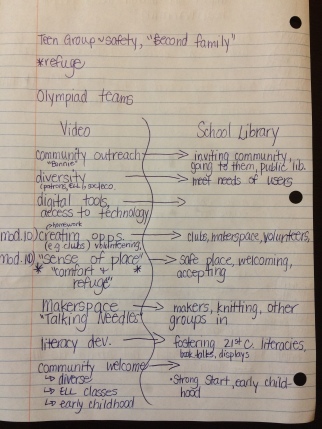I found the “Why Libraries Matter” video to be extremely moving and powerful for how it illustrates the impact that a library can have in the lives of people. With the example of the New York libraries, we see how vital a library is to those in a community who are oftentimes marginalized for a variety of reasons including language, socio-economic status, health, and culture. It is astonishing, and at the same time heart-warming, to see the large number of people lined up outside the library waiting until it opens. This alone speaks to how vital the library is to its community. This video sends a strong message, not only for the need of libraries in supporting community members and improving their lives, but also regarding how a library is the heart of a community. Once again I see our learning come full circle to reinforce the view that in schools, the library is the heart of a school community. While watching the video, the two most important aspects that stood out to me are around inclusion and diversity. Following my discussion of these are additional notes around other parallels I drew between the feature public libraries and school libraries.
A significant focus of the video and feature of libraries is the safe-haven and sense of place that is provided to people. There are numerous examples throughout the video that reinforce how libraries provide the “comfort and refuge” (Delvecchio, 2016) explored in Module 10. They are inclusive spaces, fostering a sense of place and belonging amongst the community members. So too do we strive to foster and accomplish this in school libraries. There is the example of Isaiah, the 9 year old son of the young woman we meet at the beginning of the video who goes to the library to use the computer as part of earning her nursing degree. Isaiah, who comes to the library after school to do his homework until his mom can pick him up states, “When your parent is not around, it’s like they’re your parent”, which is in reference to the librarians. The teen group that meets at the library emphasizes that they feel safe at the library and that the people they have connected with are like “a second family”. The woman who said she felt unwell and could not sleep began coming to the library to learn English and says that as a result “I feel very cheerful”. Bonnie who is homebound and receives community outreach support from the library in the form of book delivery calls in to the library and chats to the librarians. She comments that she knows all about their families. While unable to have a physical presence at the library, she is still able to connect with the library staff, and they reciprocate by deeply fostering this connection. There is also the story of the young man who receives resume-writing support. One can feel his wish and desire to better himself and achieve his career dreams, and the library is integral to this and always has been. He comments that the library has been a “key part of my life. Growing up, just needing help in school”. All of these examples illustrate the impact that the library has in creating a sense for these community members that they have a place where they feel safe, supported, believed-in, and accepted. I believe we seek to do the same in school libraries.
Another important aspect of libraries is how they can support the diversity amongst their patrons. Again, this relates back to Module 10. The video features a broad range of community members, as well as the diverse programming that supports their varying needs. It is both amazing and inspiring how the New York libraries do so. Increasingly school libraries are doing the same by re-envisioning and expanding our purpose, goals, roles, and possibilities by offering more than books to read. Clubs, Makerspaces, 21st century literacies, digital tools, inquiry, and community partnerships are just a few examples of ways school libraries are supporting their students, staff, and community at large. School libraries strive to be as diverse as their patrons, leading the way for change in exciting ways.
Below I have included my notes while watching “Why Libraries Matter”. The second picture expands on the thoughts above to include other parallels that can be drawn in the school library context.


References:
Dressner, J., & Hicks, J. (2014, May 17). Why libraries matter. Retrieved from http://www.theatlantic.com/video/index/371084/why-libraries-matter/.
Delvecchio, J. (2016). “Supporting diverse learners and creating opportunities in the school library”. LLED 462 Module 11. Vancouver, BC.